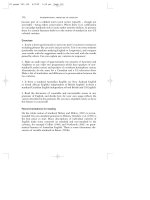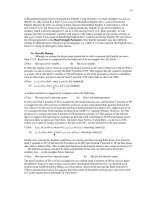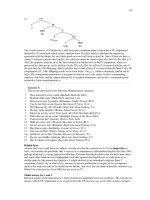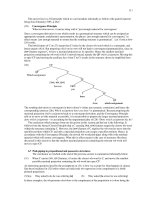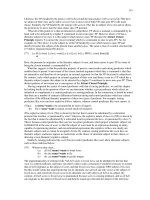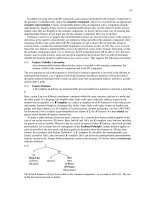Cú pháp tiếng anh part 13 ppt
Bạn đang xem bản rút gọn của tài liệu. Xem và tải ngay bản đầy đủ của tài liệu tại đây (87.71 KB, 10 trang )
121
marked degree adverb how to form the QP how many places (so that how is the specifier of this QP). Take
how in all the examples in 7 to be a degree adverb modifying many. (Irrelevantly, 7c is grammatical on a
different interpretation on which how is a manner adverb with a meaning paraphraseable as ‘In what
way?’) In 11, consider the possibility that both if and whether are complementisers in Belfast English
(though only if is a complementiser in Standard English).
Model answer for (1)
(1a) is derived as follows. The quantifier which is merged with the noun film to form the QP which film.
This in turn is merged with the (perfect participle) verb seen to form the VP seen which film. This is
merged with the (present) tense auxiliary have to form the T-bar have seen which film. The resulting T-bar
is in turn merged with the pronoun you to form the TP you have seen which film. This is merged with a
null C constituent containing [TNS, WH, EPP] features, so forming the C-bar in (i) below:
(i) C '
C TP
[TNS, WH, EPP]
ø PRN T '
you
T VP
have
V QP
seen
Q N
which film
The affixal [TNS] feature of C attracts the present tense auxiliary have to move from T to C. The
[WH, EPP] features of C attract the smallest possible maximal projection containing a wh-word to move to
spec-CP. Since the smallest maximal projection containing the wh-quantifier which is the QP which film
and since preposing this QP on its own leads to a convergent derivation which does not violate any
syntactic constraints, the QP which film moves to spec-CP. Assuming that the features of C are deleted
once their requirements are satisfied, the structure which results after head-movement and wh-movement
have applied is that shown in simplified form below:
(ii) CP
QP C '
which film
C TP
[TNS, WH, EPP]
have+ø PRN T '
you
T VP
have seen which film
_____________________________________________________________________________________
Exercise XII
Discuss the derivation of the bracketed relative clauses in 1-6 below and the exclamative clauses in
7-8. Draw tree diagrams to show the structure of each of the relative/exclamative clauses and say why they
are grammatical or ungrammatical in standard present-day varieties of English:
1a someone [who you can talk to] b someone [you can talk to]
2a someone [to whom you can talk] b *someone [to whom can you talk]
3a someone [that you can talk to] b *someone [who that you can talk to]
4a the way [he behaved] b *the way [how he behaved]
122
5a the man [whose son she has confided in] b the man [in whose son she has confided]
c *the man [whose she has confided in son] d *the man [in whose she has confided son]
6 this ever-changing world [in which we live in] (Sir Paul McCartney, Live and Let Die)
7a What courage he has shown! b *What he has shown courage!
c *What courage has he shown! d *What has he shown courage!
8 What visions have I seen! (Shakespeare: Titania, Midsummer Night’s Dream, 5.i)
Helpful hints
In relation to 4, assume that how is a pronominal manner adverb which originates as the complement of
the verb behave: try and identify the way in which how differs from other relative pronouns like
who/which/where/why. In relation to 6, say how the type of (non-standard) relative clause produced by Sir
Paul differs from its Standard English counterpart, and how relative clauses like that in 6 appear to lend
support to the copy theory of movement.
Model answer for (1a/b)
1a is derived as follows. The preposition to merges with the wh-pronoun who to form the PP to who. This
is merged with the verb talk to form the VP talk to who. The resulting VP is merged with the present tense
auxiliary can to form the T-bar can talk to who, and this is then merged with the subject you to form the
TP you can talk to who. This TP is subsequently merged with a null complementiser (perhaps a null
counterpart of that) which carries [WH, EPP] features, so deriving the structure shown in (i) below:
(i) C '
C TP
[WH, EPP]
ø PRN T '
you
T VP
can
V PP
talk
P PRN
to who
The [WH, EPP] features of C attract the smallest possible maximal projection containing a wh-word to
move to spec-CP. The smallest such maximal projection is the pronoun who, which is a maximal
projection containing a wh-word by virtue of being the largest expression headed by the wh-word who.
Hence, who moves to spec-CP, and thereby erases the [WH, EPP] features of C, so deriving the structure
shown in simplified form below, which is the superficial structure of the bracketed relative clause in 1a:
(ii) CP
PRN C '
who
C TP
[WH, EPP] you can talk to who
ø
Given that a relative pronoun occupying the specifier position in a relative clause can have a null spellout
in the PF component, an alternative possibility is for the relative pronoun who in spec-CP to be given a
null spellout at PF, so deriving (iii) below, which is the superficial structure associated with the bracketed
relative clause in 1b:
123
(iii) CP
PRN C '
who
C TP
[WH, EPP] you can talk to who
ø
______________________________________________________________________________________________
124
7.
A movement
7.1 Overview
In this chapter, we look at the syntax of subjects. So far, we have assumed that subjects
originate in the specifier position within TP and remain in situ (except where the subject undergoes
wh-movement and moves to spec-CP, e.g. in sentences like Who did he say was coming?). However, in
this chapter we shall argue that subjects originate internally within the Verb Phrase as arguments of verbs,
and are subsequently raised into the specifier position within TP, with the relevant movement operation
being triggered by an [EPP] feature carried by T. Since spec-TP is an A-position (i.e. a position which can
generally only be occupied by argument expressions), the operation by which subjects move into spec-TP
is traditionally known as A-movement.
7.2 Subjects in Belfast English
Let’s begin our discussion of the syntax of subjects by looking at some interesting data from
Belfast English (kindly supplied to me by Alison Henry). Alongside Standard English constructions like
(1a/b) below:
(1)(a) Some students should get distinctions (b) Lots of students have missed the classes
Belfast English also has structures like (2a/b):
(2)(a) There should some students get distinctions (b) There have lots of students missed the classes
Sentences like (2a/b) are called expletive structures because they contain the expletive pronoun there.
(The fact that there is not a locative pronoun in this kind of use is shown by the impossibility of replacing
it by locative here or questioning it by the interrogative locative where? or contrastively focussing it by
assigning it contrastive stress.) For the time being, let’s focus on the derivation of Belfast English
sentences like (2a/b) before turning to consider the derivation of Standard English sentences like (1a/b).
One question to ask about the sentences in (2a/b) is where the expletive pronoun there is positioned.
Since there immediately precedes the tensed auxiliary should/have, a reasonable conjecture is that there is
the subject of should/have and hence occupies the spec-TP position. If this is so, we’d expect to find that
the auxiliary can move in front of the expletive subject (via T-to-C movement) in questions – and this is
indeed the case in Belfast English, as the sentences in (3) below illustrate:
(3)(a) Should there some students get distinctions?
(b) Have there lots of students missed the classes?
But what position is occupied by the underlined quantified expressions some students/lots of students in
(3)? Since they immediately precede the verbs get/missed and since subjects precede verbs, it seems
reasonable to conclude that the expressions some students/lots of students function as the subjects of the
verbs get/missed and (since subjects are typically specifiers) occupy spec-VP (i.e. specifier position within
VP). If these assumptions are correct, (2a) will have the structure (4) below (simplified by not showing the
internal structure of the expressions some students/distinctions: we can take both of these to be
QP/Quantifier Phrase expressions, headed by the overt quantifier some in one case and by a null quantifier
[
Q
ø] in the other):
125
(4) CP
C TP
ø
PRN T '
there
T VP
should
QP V '
some students
V QP
get ø distinctions
The analysis in (4) claims that the sentence contains two subjects/specifiers: there is the specifier (and
syntactic subject) of should, and some students is the specifier (and semantic subject) of get.
Given the assumptions in (4), sentence (2a) will be derived as follows. The noun distinctions merges
with a null quantifier [
Q
ø] to form the QP ø distinctions. By virtue of being the complement of the verb
get, this QP is merged with the V get to form the V-bar (incomplete verb expression) get ø distinctions.
The resulting V-bar is then merged with the subject of get, namely the QP some students (itself formed by
merging the quantifier some with the noun students), so deriving the VP some students get ø distinctions.
This VP is in turn merged with the Tense auxiliary should, forming the T-bar should some students get ø
distinctions. Let’s suppose that a finite T has an [EPP] feature requiring it to have a specifier with
person/number properties. In sentences like (2a/b) in Belfast English, the requirement for T to have such a
specifier can be satisfied by merging expletive there with the T-bar should some students get ø
distinctions, so forming the TP There should some students get ø distinctions. The resulting TP is then
merged with a null declarative complementiser, forming the CP shown in (4) above.
But what about the derivation of the corresponding Standard English sentence (1a) Some students
should get distinctions? Let’s suppose that the derivation of (1a) runs parallel to the derivation of (2a) until
the point where the auxiliary should merges with the VP some students get ø distinctions to form the
T-bar should some students get ø distinctions. As before, let’s assume that [
T
should] has an [EPP] feature
requiring it to project a structural subject/specifier. But let’s also suppose that the requirement for
[
T
should] to have a specifier of its own cannot be satisfied by merging expletive there in spec-TP because
in standard varieties of English there can generally only occur in structures containing an intransitive verb
like be, become, exist, occur, arise, remain etc. Instead, the [EPP] requirement for T to have a subject with
person/number properties is satisfied by moving the subject some students from its original position in
spec-VP into a new position in spec-TP, in the manner shown by the arrows below:
(5) CP
C TP
ø
QP T '
Some students
T VP
should
QP V '
some students
V QP
get distinctions
Since spec-TP is an A-position which can only be occupied by an argument expression (i.e. an expression
which is the subject or complement of a verb or other predicate), the kind of movement operation
illustrated by the dotted arrow in (5) is called A-movement.
Given the arguments presented in chapters 5 and 6 that Head Movement and Wh-Movement are
composite operations involving copying and deletion, we would expect the same to be true of
A-movement. One piece of evidence in support of a copying analysis of A-movement comes from scope
126
facts in relation to sentences such as (6a) below, which will have the syntactic structure shown in
simplified form in (6b) if everyone originates as the subject of the verb finished and is then raised up (by
A-movement) to become the subject of the present tense auxiliary have:
(6)(a) Everyone hasn’t finished the assignment yet
(b) [
CP
[
C
ø] [
TP
Everyone [
T
has] [
NegP
not [
Neg
ø] [
VP
everyone [
V
finished] the assignment yet]]]]
For many speakers, sentences like (6a) are ambiguous between (i) a reading on which the quantifier
expression everyone has scope over not so that the sentence means much the same as ‘Everyone is in the
position of not having finished the assignment yet’, and (ii) another reading on which everyone falls
within the scope of not (so that the sentence means much the same as ‘Not everyone has finished the
assignment yet’). We can account for this scope ambiguity in a principled fashion if we suppose that
A-movement involves copying, that scope is defined in terms of c-command (so that a scope-bearing
constituent has scope over constituents which it c-commands), and that the scope of a universally
quantified expression like everyone in negative structures like (6b) can be determined either in relation to
the initial position of everyone or in relation to its final position. In (6b) everyone is initially merged in a
position (marked by strikethrough) in which it is c-commanded by (and so falls within the scope of) not;
but via A-movement it ends up in an (italicised) position in which it c-commands (and so has scope over)
not. The scope ambiguity in (6a) therefore reflects the two different positions occupied by everyone in the
course of the derivation. (See Lebeaux 1995, Hornstein 1995, Romero 1997, Sauerland 1998, Lasnik
1998/1999, Fox 2000, and Boeckx 2000/2001 for discussion of scope in A-movement structures.)
The claim that (non-expletive) subjects like some students/lots of students in sentences like (1)
originate internally within the VP containing the relevant verb (and from there move into spec-TP in
sentences like (1) above) is known in the relevant literature as the VP-Internal Subject Hypothesis
(= VPISH), and has been widely adopted in research since the mid 1980s. An extensive body of evidence
was adduced in support of the hypothesis from a variety of sources and languages in the 1980s and early
1990s, e.g. in Kitagawa (1986), Speas (1986), Contreras (1987), Zagona (1987), Kuroda (1988), Sportiche
(1988), Rosen (1990), Ernst (1991), Koopman and Sportiche (1991), Woolford (1991), Burton and
Grimshaw (1992), McNally (1992), Guilfoyle, Hung and Travis (1992), and Huang (1993). Since then, it
has become a standard analysis. Below, we look at some of the evidence in support of VPISH.
7.3 Idioms
Empirical evidence in support of the VP-Internal Subject Hypothesis comes from the syntax of
idioms. We can define idioms as expressions (like those italicized below) which have an idiosyncratic
meaning which is not a purely compositional function of the meaning of their individual parts:
(7)(a) Let’s have a couple of drinks to break the ice
(b) Be careful not to upset the applecart
(c) The president must bite the bullet
There seems to be a constraint that only a string of words which forms a unitary constituent can be an
idiom. So, while we find idioms like those in (7) which are of the form verb+complement (but where the
subject isn’t part of the idiom), we don’t find idioms of the form subject+verb where the verb has a
complement which isn’t part of the idiom: this is because in subject+verb+complement structures, the
verb and its complement form a unitary constituent (a V-bar), whereas the subject and the verb do not –
and only unitary constituents can be idioms.
In the light of the constraint that an idiom is a unitary constituent with an idiosyncratic interpretation,
consider idioms such as the following:
(8)(a) All hell broke loose (b) The shit hit the fan (c) The cat got his tongue
In (8), not only is the choice of verb and complement fixed, but so too is the choice of subject. In such
idioms, we can’t replace the subject, verb or complement by near synonyms – as we see from the fact that
sentences like (9) below are ungrammatical (on the intended idiomatic interpretation):
(9)(a) *The whole inferno escaped
(b) *Camel dung was sucked into the air conditioning
(c) *A furry feline bit his lingual articulator
127
However, what is puzzling about idioms like (8) is that one or more auxiliaries can freely be positioned
between the subject and verb: cf.
(10)(a) All hell will break loose (11)(a) The shit might hit the fan
(b) All hell has broken loose (b) The shit has hit the fan
(c) All hell could have broken loose (c) The shit must have hit the fan
How can we reconcile our earlier claim that only a string of words which form a unitary constituent can
constitute an idiom with the fact that all hell break loose is a discontinuous string in (10), since the
subject all hell and the predicate break loose are separated by the intervening auxiliaries will/has/could
have? To put the question another way: how can we account for the fact that although the choice of
subject, verb and complement is fixed, the choice of auxiliary is not?
The VP-Internal Subject Hypothesis provides a straightforward answer, if we suppose that subjects
originate internally within VP, and that clausal idioms like those in (8) are VP idioms which require a
fixed choice of head, complement and specifier in the VP containing them. For instance, in the case of
(8a), the relevant VP idiom requires the specific word break as its head verb, the specific adjective loose
as its complement, and the specific quantifier phrase all hell as its subject/specifier. We can then account
for the fact that all hell surfaces in front of the auxiliary will in (10a) by positing that the QP all hell
originates in spec-VP as the subject of break loose, and is then raised (via A-movement) into spec-TP to
become the subject of will break loose. Given these assumptions, (10a) will be derived as follows. The
verb break merges with the adjective loose to form the idiomatic V-bar break loose. This is then merged
with its QP subject all hell to form the idiomatic VP all hell break loose. The resulting VP is merged with
the tense auxiliary will to form the T-bar will all hell break loose. Since finite auxiliaries carry an [EPP]
feature requiring them to have a subject specifier with person/number features, the subject all hell moves
from being the subject of break to becoming the subject of will – as shown in simplified form in below:
(12) TP
QP T '
all hell
T VP
will
QP V '
all hell
V A
break loose
We can then say that (in the relevant idiom) all hell must be the sister of break loose, and that this
condition will be met only if all hell originates in spec-VP as the subject (and sister) of the V-bar break
loose. We can account for how the subject all hell comes to be separated from its predicate break loose by
positing that subjects originate internally within VP and from there raise to spec-TP (via A-movement)
across an intervening T constituent like will, so that the subject and predicate thereby come to be separated
from each other – movement of the subject to spec-TP being driven by an [EPP] feature carried by [
T
will]
requiring will to have a subject with person/number features. Subsequently, the TP in (12) is merged with
a null declarative complementiser, so deriving the structure associated with (10a) All hell will break loose.
7.4 Argument structure and theta roles
The assumption that subjects originate internally within VP ties up in interesting ways with
traditional work in predicate logic which maintains that propositions (which can be thought of as
representing the substantive semantic content of clauses) comprise a predicate and a set of arguments.
Simplifying somewhat, we can say that a predicate is an expression denoting an activity or event, and an
argument is an expression denoting a participant in the relevant activity or event. For example, in
sentences such as those below, the italicised verbs are predicates and the bracketed expressions represent
their arguments.
(13)(a) [The guests] have arrived
(b) [The police] have arrested [the suspect]
128
In other words, the arguments of a verb are typically its subject and complement(s). A verb like arrive
when used with a single bracketed argument in a structure like (13a) is said to be a one-place predicate;
and a verb like arrest when used with two bracketed arguments in a structure like (13b) is said to be a
two-place predicate.
However, there is an important sense in which it is not enough simply to say that in a sentence such as
(13b) The police have arrested the suspect the verb arrest is a predicate which has two arguments – the
subject argument the suspect and the complement argument the police. After all, such a description fails to
account for the fact that these two arguments play very different semantic roles in relation to the act of
arrest – i.e. it fails to account for the fact that the police are the individuals who perform the act (and
hence get to verbally and physically abuse the suspect), and that the suspect is the person who suffers the
consequences of the act (e.g. being manhandled, handcuffed, thrown into the back of a windowless vehicle
and beaten up). Hence, any adequate account of argument structure should provide a description of the
semantic role which each argument plays.
In research spanning half a century – beginning with the pioneering work of Gruber (1965), Fillmore
(1968), and Jackendoff (1972) – linguists have attempted to devise a universal typology of the semantic
roles played by arguments in relation to their predicates. In the table in (14) below are listed a number of
terms used to describe some of these roles (the convention being that terms denoting semantic roles are
CAPITALISED), and for each role an informal gloss is given, together with an illustrative example in
parentheses (in which the italicized expression has the semantic role specified):
(14) List of roles played by arguments with respect to their predicates
Role Gloss Example
THEME Entity undergoing the effect of some action Mary fell over
AGENT Entity instigating some action Debbie killed Harry
EXPERIENCER Entity experiencing some psychological state I like syntax
LOCATIVE Place in which something is situated or takes place He hid it under the bed
GOAL Entity representing the destination of some other entity John went home
SOURCE Entity from which something moves He returned from Paris
INSTRUMENT Means used to perform some action He hit it with a hammer
We can illustrate how the terminology in (14) can be used to describe the semantic roles played by
arguments in terms of the following examples:
(15)(a) [The FBI] arrested [Larry Luckless] (b) [The suspect] received [a caution]
[AGENT] [THEME] [GOAL] [THEME]
(c) [The audience] enjoyed [the play] (d) [The president] went [to Boston]
[EXPERIENCER] [THEME] [THEME] [GOAL]
(e) [They] stayed [in a hotel] (f) [The noise] came [from the house]
[THEME] [LOCATIVE] [THEME] [SOURCE]
Given that – as we see from these examples – the THEME role is a central one, it has become customary
over the past two decades to refer to the relevant semantic roles as thematic roles; and since the Greek
letter q (= theta) corresponds to th in English and the word thematic begins with th, it has also become
standard practice to abbreviate the expression thematic role to q-role (pronounced theeta-role by some
and thayta-role by others). Using this terminology, we can say (e.g.) that in (15a) the FBI is the AGENT
argument of the predicate arrested, and that Larry Luckless is the THEME argument of arrested.
Thematic relations (like AGENT and THEME) play a central role in the description of a range of
linguistic phenomena. For example, it has been argued that the distribution of certain types of adverb is
adverb is thematically determined. Thus, Gruber (1976) argues that adverbs like deliberately can only be
used to modify AGENT arguments: cf.
(16)(a) John (= AGENT) deliberately rolled the ball down the hill
(b) *The ball (= THEME) deliberately rolled down the hill
Likewise, Fillmore (1972, p.10) argues that the adverb personally must be associated with an
EXPERIENCER argument: cf.
129
(17)(a) Personally, your proposal doesn’t interest me (= EXPERIENCER)
(b) *Personally, you hit me (= THEME)
For further discussion of the role played by thematic structure in syntax, see Radford (1988, pp.372-92).
If we look closely at the examples in (15), we see a fairly obvious pattern emerging. Each of the
bracketed argument expressions in (15) carries one and only one q-role, and no two arguments of any
predicate carry the same q-role. Chomsky (1981) suggested that these thematic properties of arguments
are the consequence of a principle of Universal Grammar traditionally referred to as the q criterion, and
outlined in (18) below:
(18) q-criterion
Each argument bears one and only one q-role, and each q-role is assigned to one and only one
argument (Chomsky 1981, p.36)
A principle along the lines of (18) has been assumed (in some form or other) in much subsequent work.
However, an important question raised by (18) is precisely how arguments come to be assigned
theta-roles. To put this question in a more concrete form, consider how the object the suspect comes to be
assigned its theta-role of THEME complement of the predicate arrested in (13b) The police have arrested
the suspect. Since the suspect is the complement of the verb arrested and since verbs merge with their
complements, a principled answer would be to suppose that theta-roles are assigned to arguments in
accordance with the hypothesis (19) below:
(19) Predicate-Internal Theta-Marking Hypothesis/PITMH
An argument is theta-marked (i.e. assigned a theta-role) via merger with a predicate
The hypothesis in (19) will also account for the theta-marking of subjects, if we assume that subjects
originate as arguments of verbs. To see how, let’s look at the derivation of (13b) The police have arrested
the suspect.
The verb arrested merges with its direct object complement the suspect (a DP formed by merging the
determiner the with the noun suspect). In accordance with PITMH (19), the object the suspect will be
theta-marked via merger with the verbal predicate arrested. If the lexical entry for the verb arrest specifies
that its complement plays the thematic role of THEME argument of arrest, merging the verb arrested with
its complement the suspect will result in the suspect being assigned the theta-role of THEME argument of
arrested. The V-bar thereby formed is then merged with the subject DP the police (itself formed by
merging the determiner the with the noun police) to form the VP shown in (20) below (simplified by not
showing the internal structure of the two DPs):
(20) VP
DP V '
the police
V DP
arrested the suspect
If the lexical entry for the verb arrest specifies that its subject has the thematic role of AGENT argument of
arrest, merging the police with the V-bar arrested the suspect will result in the police being assigned the
theta-role of AGENT argument of the predicate arrested. Introducing some new terminology at this point,
we can say that in a structure such as (20), the complement the suspect is the internal argument of the
verb arrested (in the sense that it is the argument contained within the immediate V-bar projection of the
verb, and hence is a sister of the verb), whereas the subject the police is the external argument of the
verb arrested (in that it occupies a position external to the V-bar constituent which is the immediate
projection of the verb arrested). We can equivalently say that the verb arrested is first-merged with its
complement the suspect and second-merged with its subject the police.
The VP in (20) is then merged with the present tense auxiliary [
T
have], forming the T-bar have the
police arrested the suspect. Since a finite T has an [EPP] feature requiring it to have a subject of its own,
the DP the police moves from being the subject of arrested to becoming the subject of [
T
have], forming
The police have the police arrested the suspect. Merging the resulting TP with a null complementiser
marking the declarative force of the sentence in turn derives the (simplified) structure in (21) below:
130
(21) CP
C TP
ø
DP T '
the police
T VP
have
DP V '
the police
V DP
arrested the suspect
The analysis in (21) is consistent with the θ-criterion (18) in that each argument is assigned a single
theta-role which is different from that assigned to any other argument of the same predicate (the suspect
being the THEME argument of arrested and the police being its AGENT argument). (21) is also consistent
with the Predicate-Internal Theta-Marking Hypothesis (19), since the suspect is assigned the thematic
role of THEME argument of arrested by being first-merged with arrested, and the police is assigned the
thematic role of AGENT argument of arrested by being second-merged with arrested. Since only
predicative heads can assign theta-roles, and since neither T nor C is a predicative head, neither T nor C
assigns any theta-role to any constituent in (21).
Our discussion here suggests that thematic considerations lend further support to the VP-Internal
Subject Hypothesis. By positing that all arguments of a verb (including its subject) originate internally
within VP, we can arrive at a unitary and principled account of q-marking in terms of the Predicate-
Internal Theta-Marking Hypothesis (21), since we can say that a verb only theta-marks an argument with
which it is merged (via a first- or second-merge operation).
7.5 Unaccusative predicates
The overall conclusion to be drawn from our discussion so far is that subjects originate
internally within VP, as theta-marked arguments of the verb. In all the structures we have looked at until
now, the verb phrase has contained both a complement and a specifier (the specifier being the subject of
the verb). However, in this and subsequent sections we look at VPs containing a verb and a complement
but no specifier, and where it is the complement of the verb which subsequently moves to spec-TP.
One such type of VP are those headed by a special subclass of intransitive verbs which are known as
unaccusative predicates for reasons which will become apparent shortly. In this connection, consider the
syntax of the italicized arguments in structures such as the following:
(22)(a) There have arisen several complications
(b) There could have occurred a diplomatic incident
(c) There remains little hope of finding survivors
The fact that the italicised expressions are positioned after the bold-printed verbs suggests that they
function as the complements of the relevant verbs – and indeed there is syntactic evidence in support of
this view. Part of the evidence comes from their behaviour in relation to a constraint on movement
operations discovered by Huang (1982) which can be characterised informally in the following terms:
(23) Constraint on Extraction Domains/CED
Only complements allow material to be extracted out of them, not specifiers or adjuncts.
We can illustrate Huang’s CED constraint in terms of the following contrasts:
(24)(a) He was taking [pictures of who]? (b) Who was he taking [pictures of who]?
(25)(a) [Part of what] has broken? (b) *What has [part of what] broken?
(26)(a) He was angry [when she hid what]? (b) *What was he angry [when she hid what]?
(24a/25a/26a) are echo questions in which the wh-pronoun who/what remains in situ, while (24b/25b/26b)
are their wh-movement counterparts. In (24), who is extracted out of a bracketed nominal expression

